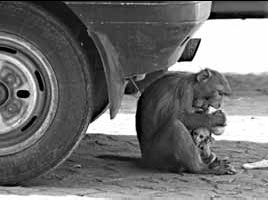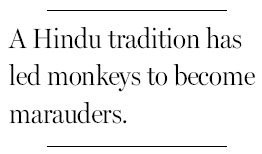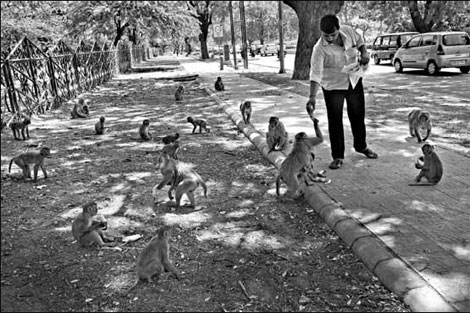Aggressive monkeys are overrunning Delhi
Updated: 2012-06-03 07:52
By Gardiner Harris(The New York Times)
|
|||||||
|
Urbanization has encroached on the habitat of monkeys in India. If the animals aren't given food, they are known to steal it. Photographs by Suzanne Lee for the New York Times |
NEW DELHI - The first interloper stepped in front of her on the sidewalk and silently held up his hand. The second appeared behind her and beckoned for her bag. Maeve O'Connor was trapped.
Resistance would have been dangerous, so Ms. O'Connor handed it over. The two sauntered away. The encounter lasted about 15 seconds - just one more coordinated mugging by rhesus monkeys in a city increasingly plagued by them.
"I had other bags with me, but they knew the bag that had the fresh bread in it," she said.
"They were totally silent, very quick and highly effective."
The monkey population of Delhi has grown so large and aggressive that city officials have petitioned India's Supreme Court to relieve them of the task of monkey control.
"We have trapped 13,013 monkeys since 2007," said R. B. S. Tyagi, director of veterinary services for Delhi's city government. Nonetheless, Delhi's monkey population has increased.

The reason is simple: people feed them. Monkeys are the living representatives of the Hindu god Hanuman, and tradition calls for feeding them on Tuesdays and Saturdays.
"This problem will never be solved" as long as Hindus feed monkeys regularly, said R. M. Shukla, the city's chief wildlife warden.
In 2007, a Delhi deputy mayor died when he fell from his terrace after being attacked by monkeys. In May a 14-year-old girl was seriously injured when she fell from the roof of a building after monkeys pursued her.
Stories abound in Delhi of monkeys' entering homes, ripping out wiring, stealing clothes and biting those who surprise them. They treat the Indian Parliament building as a playground, have invaded the prime minister's office and Defense Ministry, and sometimes ride buses and subway trains.
Some residents are getting a bigger monkey, a langur, to urinate around their homes. The acrid smell scares the rhesus monkeys away for weeks. But as soon as the odor disappears, the rhesus monkeys return.
Amar Singh, a langur handler, recently watched one of his langurs in the yard of a home in Delhi's diplomatic neighborhood. The langur, a large monkey with a black face dramatically framed by white fur, was tied to a pole with a 1.8-meter leash.
Mr. Singh said that he had 65 langurs urinating on homes and buildings throughout Delhi. He charges about $200 a month.

The city pays people $12 for every monkey they catch. But years of using cages baited with fruit and nuts have taught the monkeys to avoid the traps.
Trapped monkeys are brought to a sanctuary in the south of Delhi, but residents who live nearby say their lives have been ruined by the influx. Monkeys easily scale the walls and often find their way back to Delhi's central neighborhoods.
Kali, who uses one name, said her daughter and niece had been bitten twice. For a poor family like hers, the monkeys are a constant threat in more ways than one. "I give them my leftovers like roti," she said. "But then they ran away with my onions."
Nikhila Gill contributed reporting.
The New York Times
(China Daily 06/03/2012 page10)
